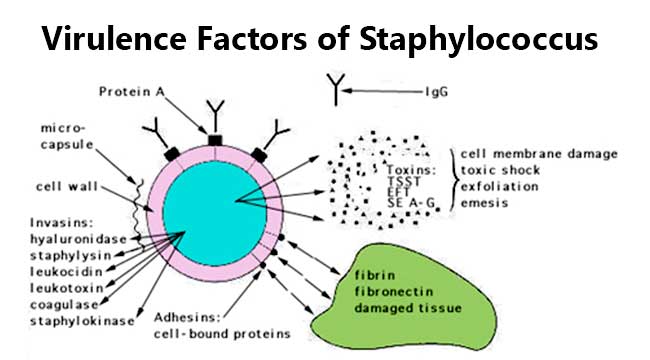A. Cell Wall Associated | |
Virulence Factors | Functions |
| Peptidoglycan | – Pyrogenicity – Complement Activation – Inhibition of leukocyte migration |
| Techoic Acid | – Adherence to mucosal surfaces |
| Capsule | – Diffusion Barrier – Prevents Phagocytosis – Capsular serotypes 5 and 8 are most frequently associated with bacteremia and infections |
B. Cell Surface Associated | |
Virulence Factors | Functions |
| Protein A | – Basis for Coagglutination Test, used in laboratories for organisms identification (e.g., Gonococci and Streptococci) – Binds to Fc region of all human IgG subclasses except IgG3 |
| Clumping Factor | – Detected by slide test for bound coagulase |
C. Extracellular Enzymes | |
Virulence Factors | Functions |
| Coagulase | – Clots plasma in the absence of calcium – Reacts with coagulase-releasing factor (CRF) and the resulting complex (staphylothrombin), converts fibrinogen to fibrin – Eight Types (most common type is A) – Detected by tube test for free coagulase |
| Staphylokinase | – Binds to plasminogen and activates it to the fibrinolytic enzyme plasmin |
| Lipase | – Hydrolyzes triglycerides |
| Thermonuclease | – Hydrolyzes RNA and DNA |
| Urease | – Hydrolyzes urea to ammonia – Plays role in the invasiveness of S. saprophyticus in the urinary tract |
| Hyaluronate Lyase (Hyaluronidase) | – Aids in invasiveness by breakdown of Hyaluronate rich tissue barriers (accounts for persistence of Staphylococcus in tissues) |
| Proteases | – Cleave and Degrade host proteins |
D. Hemolysins | |
Virulence Factors | Functions |
| α-Hemolysin | – Most important hemolysis – Lyses RBCs of several animal species – Leucocidal, cytotoxic, neurotoxic, and dermonecrotic activities – Leads to β-hemolysis around colonies |
| β-Hemolysin | – Sphingomyelinase activity on RBCs (responsible for CAMP test) – Displays hot-cold phenomenon |
| δ-Hemolysin | – Surfactant on various cells: erythrocytes, leucocytes, bacterial protoplasts |
| γ-Hemolysin | – γ-Hemolysins composed of two proteins |
| Leukocidin | – Also called Panton-Valentine Toxin |
E. Toxins | |
Virulence Factors | Functions |
| Enterotoxin A through E, H, I (the most common type is A) | – Pyrogenic toxin Superantigen – Heat Stable – Responsible for Staphylococcal food poisoning – Mechanism of action: Increase intestinal peristalsis by increased vagal stimulation – Ingestion of preformed exotoxin in food (baked food, custards, potato salad, processed meats, fish, milk products, ice creams) – Nausea/Vomiting with or without diarrhea in 1 to 6 hours – Self Limiting. No role of antibiotics |
| Toxic Shock Syndrome Toxin-1 (TSST-1); formerly known as enterotoxin F or pyrogenic exotoxin C | – It is also a Superantigen, leading to a systemic release of a variety of cytokines which is the cause of multisystem involvement in TSS, mostly seen in menstruating women using highly absorbent vaginal tampons – Resistant to inactivation by heat and proteolytic enzymes – Pyrogenic, causes erythroderma and endotoxin shock – Treatment: Clindamycin |
| Exfoliative TOXIN (epidermolytic toxin) ET A and ET B | – Has Superantigen Activity – ET A: thermostable – ET B: heat labile – Dissolve the mucopolysaccharide matrix of epidermis, resulting in intraepithelial splitting of cellular linkages in stratum granulosum and intraepidermal blistering leading to SSSS (Staphylococcal Scalded Skin Syndrome) – Severe form of the SSSS is known as Ritter’s disease in the new born – Milder forms are pemphigus neonatorum and bullous impetigo |


Are the virulent factors of gram + bacteria the same
Pleas i want information about pathogenesis of staphylococcus and molecular pathogenic of staphylocococcus aureus and epidermidis